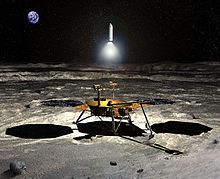MoonRise
| Mission type | Lunar sample return |
|---|---|
| Operator | NASA / Jet Propulsion Laboratory |
MoonRise is a robotic mission concept to the south pole of the
MoonRise was not selected for the third New Frontiers program mission 3, losing out to the OSIRIS-REx asteroid sample return mission,[2] and it lost again in the 2017 competition for New Frontiers program mission 4.[3]
Science objectives


MoonRise has the following objectives:[1]
- Determine the impact chronology of the SPA basin
- Investigate processes associated with the formation of large impact basins
- Investigate the materials excavated from the deeper crust, and possibly the mantle, of the Moon within the SPA basin
- Determine rock types, distribution of thorium, and implications for the Moon's thermal evolution
- Sample and analyze basaltic rock and volcanic glass, which record the composition and chemical evolution of the Moon's far-side mantle beneath the SPA basin
Future prospects
MoonRise received Phase A funding out of the New Frontiers program.[4] The study was one of three concepts to get US$3.3 million funding in 2010 to further develop the mission for the final selection, which was a US$650 million mission to launch in the late 2010s.[5] The three semi-finalists were MoonRise, the OSIRIS-REx sample return mission, and the Venus In Situ Explorer mission.[5]
Although MoonRise was passed over in favor of OSIRIS-REx in the 2011 selection, a South Pole–Aitken basin sample return mission remains part of the 2013–2022 Planetary Science Decadal Survey's recommendation for potential New Frontiers missions,[6] and NASA's Planetary Science Division has expressed support for the Decadal Survey's recommendations.[7]
See also
- Origin of the Moon
- Stardust, a 1999 cometary coma sample return mission
References
- ^ a b "MoonRise" (PDF). NASA Facts. NASA. June 2010. Archived from the original (PDF) on 16 May 2011.
- ^ Clark, Stephen (25 May 2011). "NASA picks robotic asteroid voyager for liftoff in 2016". Spaceflight Now. Retrieved 19 November 2016.
- ^ Glowatz, Elana (20 December 2017). "NASA's New Frontier Mission Will Search For Alien Life Or Reveal The Solar System's History". International Business Times. Retrieved 14 January 2018.
- ^ Alkalai, L.; Jolliff, B.; Papanastassiou, D. (2010). An Overview of the MoonRise Lunar Sample Return Mission from the South Pole-Aitken Basin (PDF). 7th International Planetary Probe Workshop. 14–18 June 2010. Barcelona, Spain. Archived from the original (PDF) on 20 November 2016.
- ^ a b "WUSTL-led Moon mission is finalist for NASA's next big space venture". Washington University in St. Louis. 31 December 2009.
- ISBN 978-0-309-22464-2.
- ^ Weiler, Edward J. (29 July 2011). "Archived copy" (PDF). Letter to Charles F. Kennel. Archived from the original (PDF) on 7 January 2017. Retrieved 20 November 2016.
{{cite press release}}: CS1 maint: archived copy as title (link)
External links
